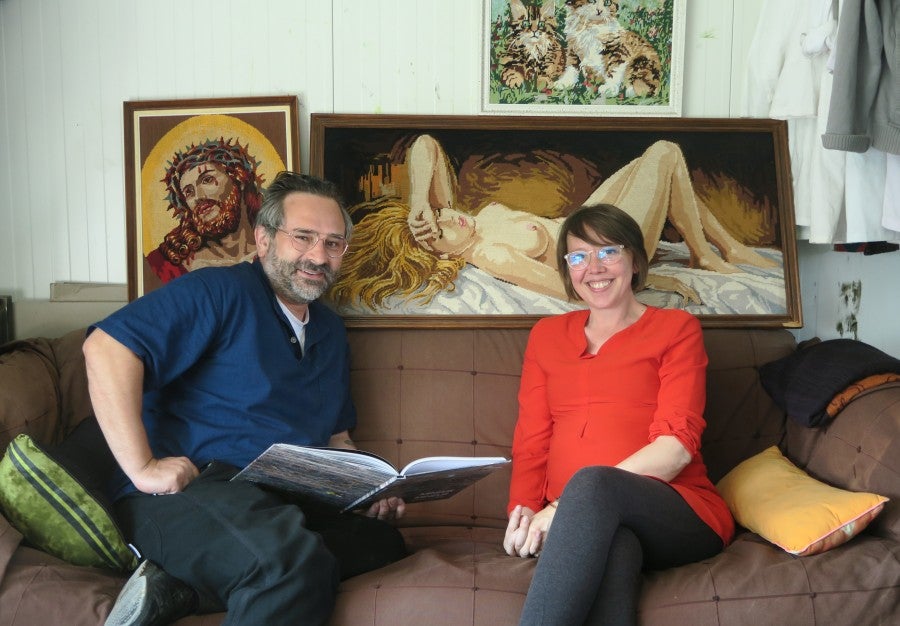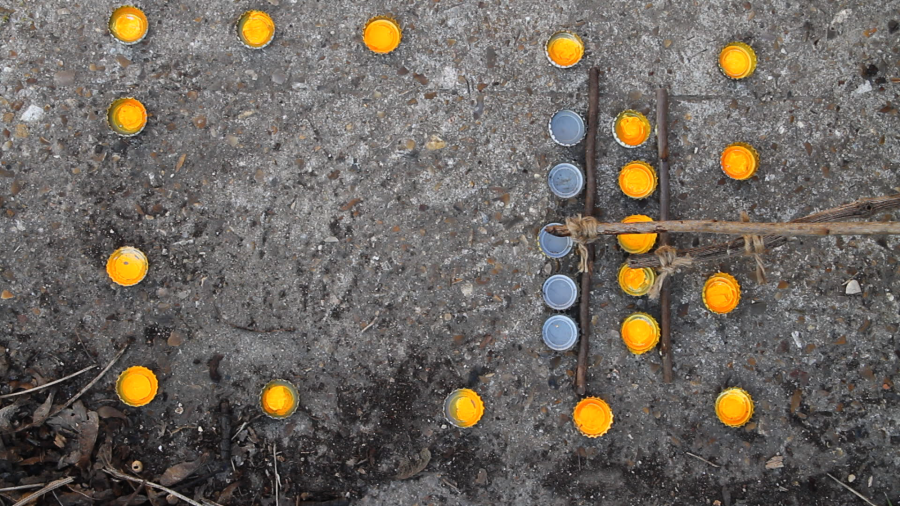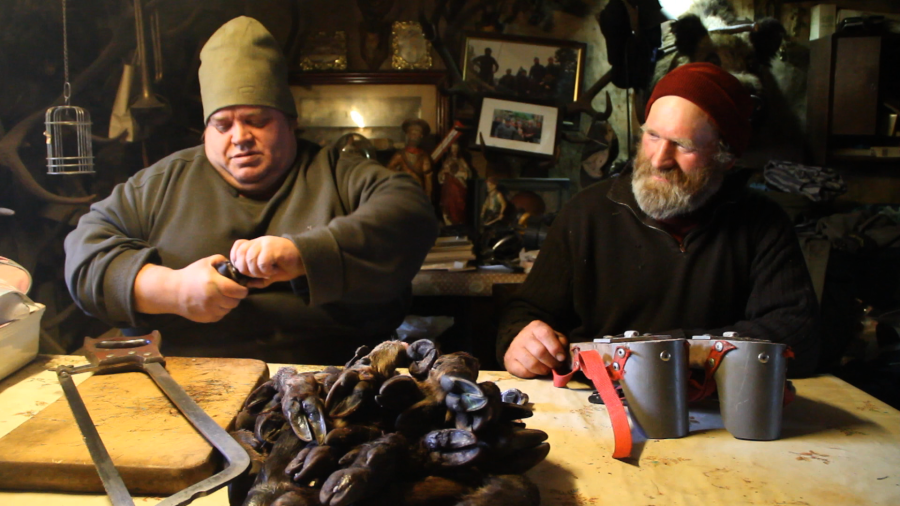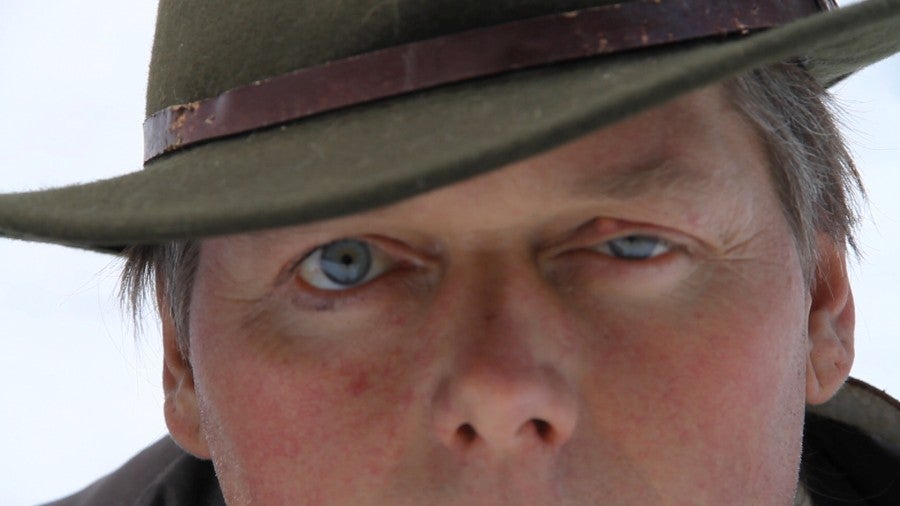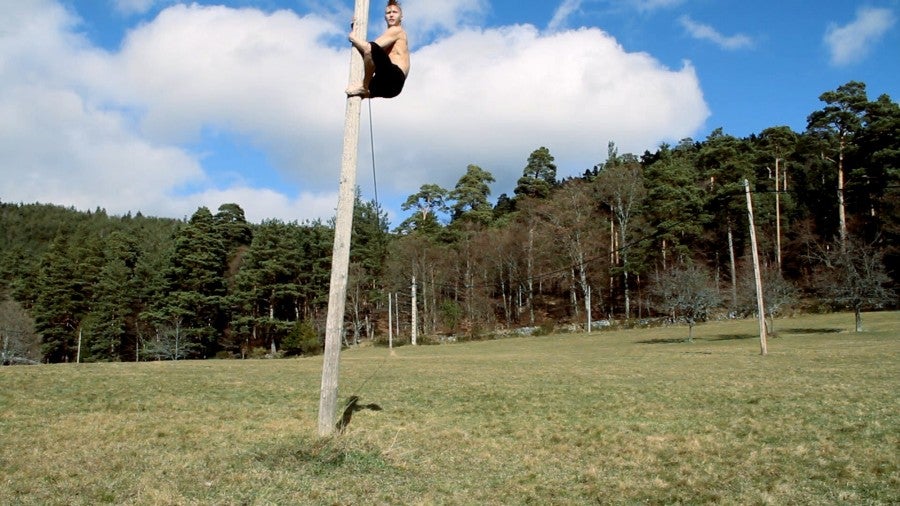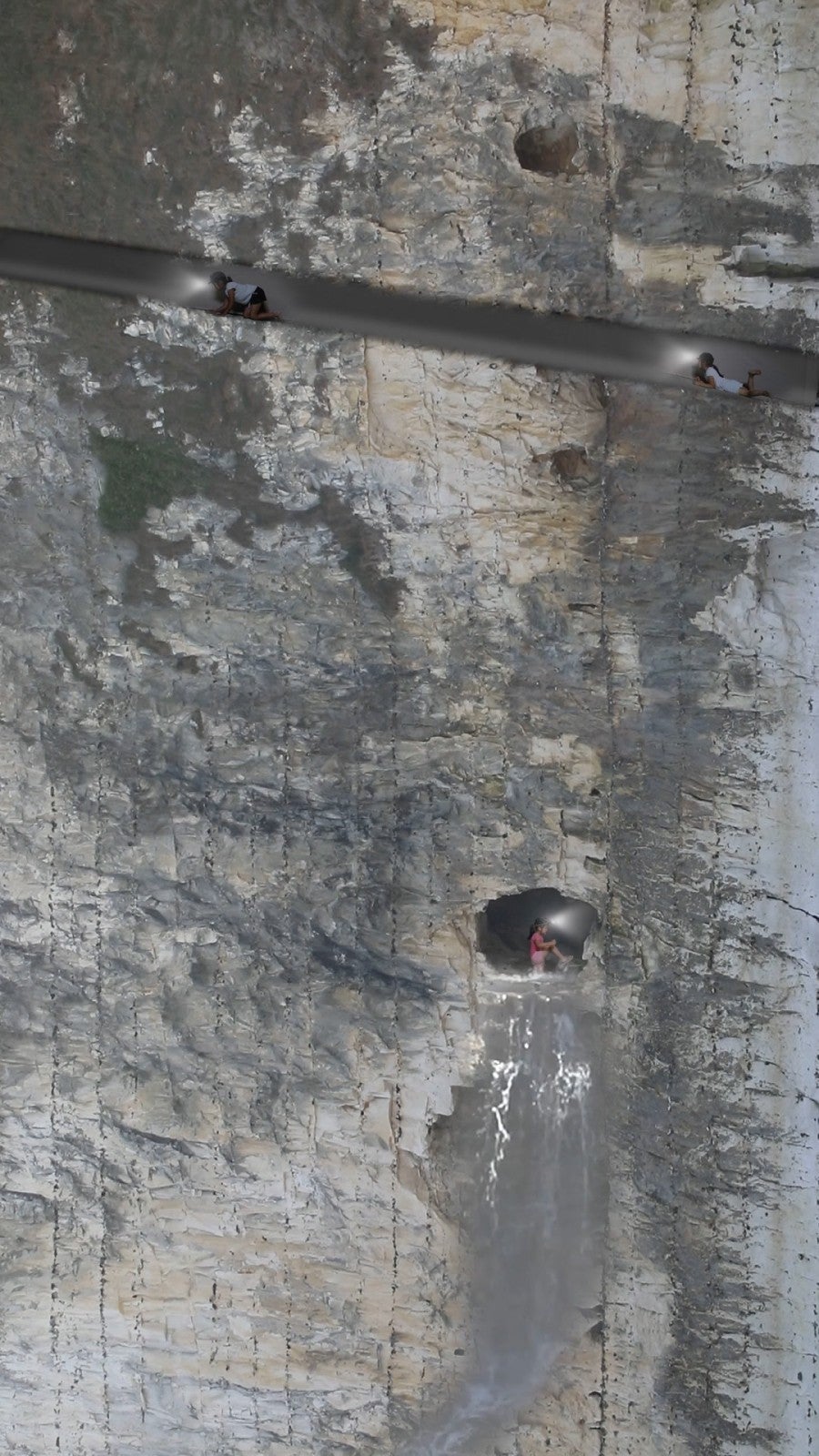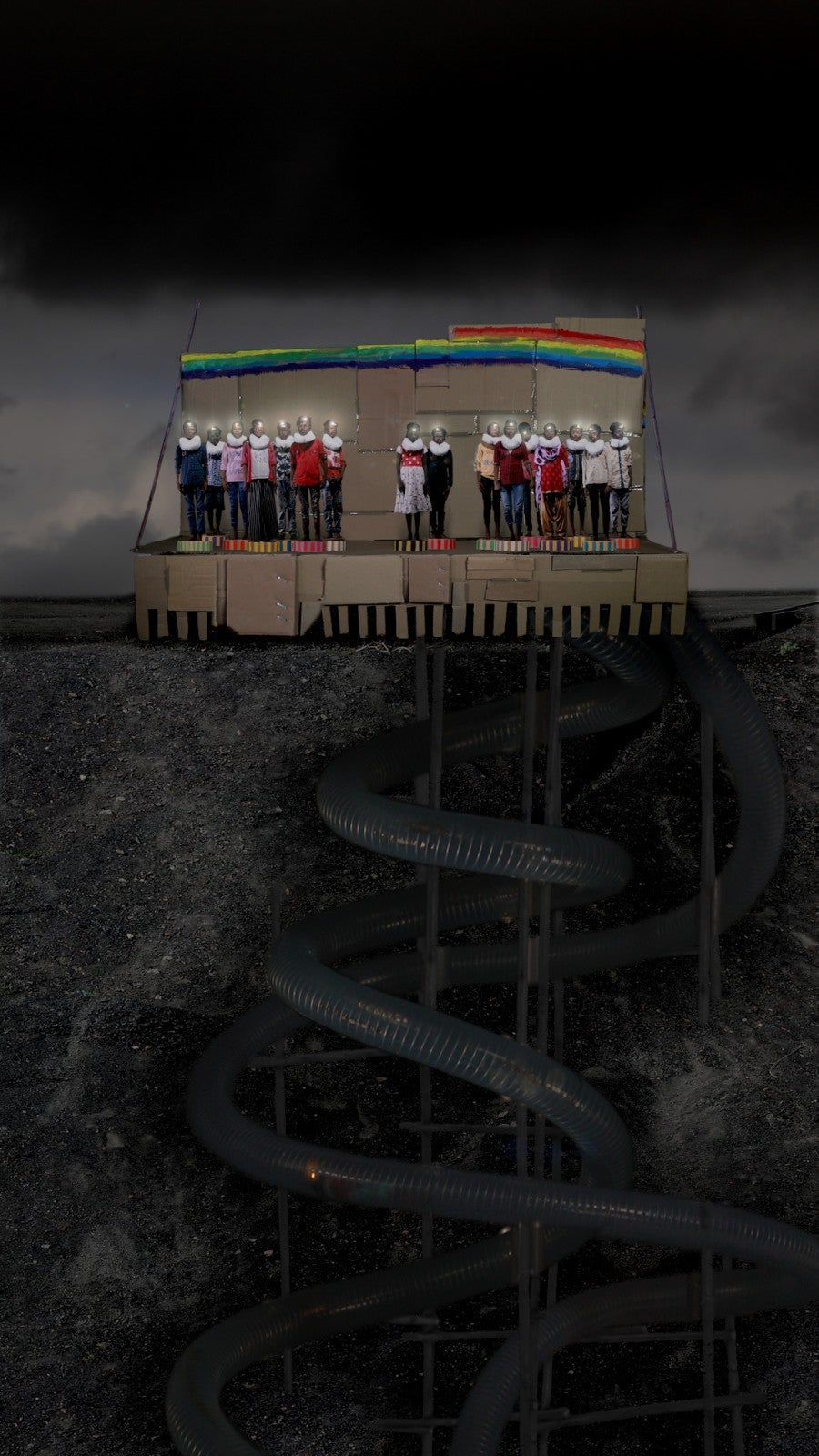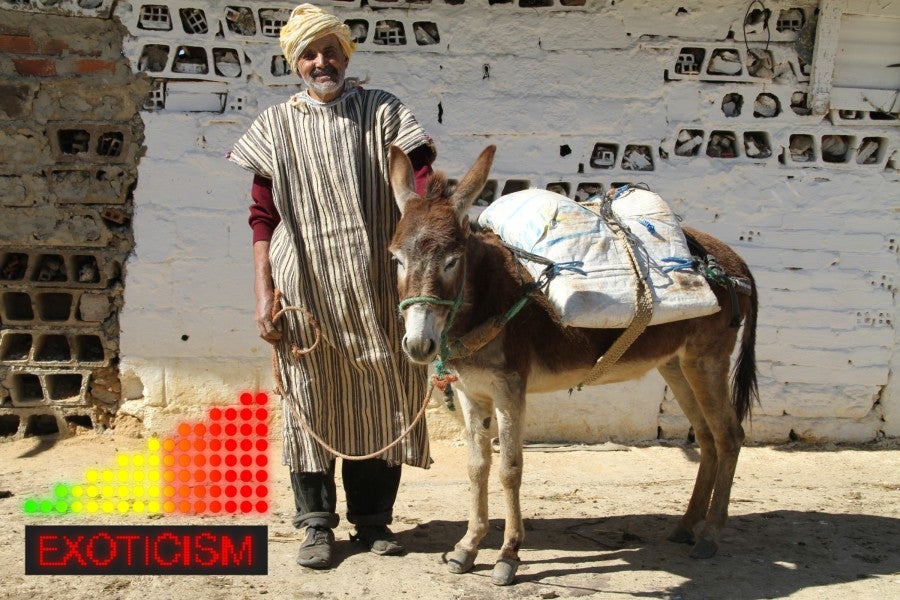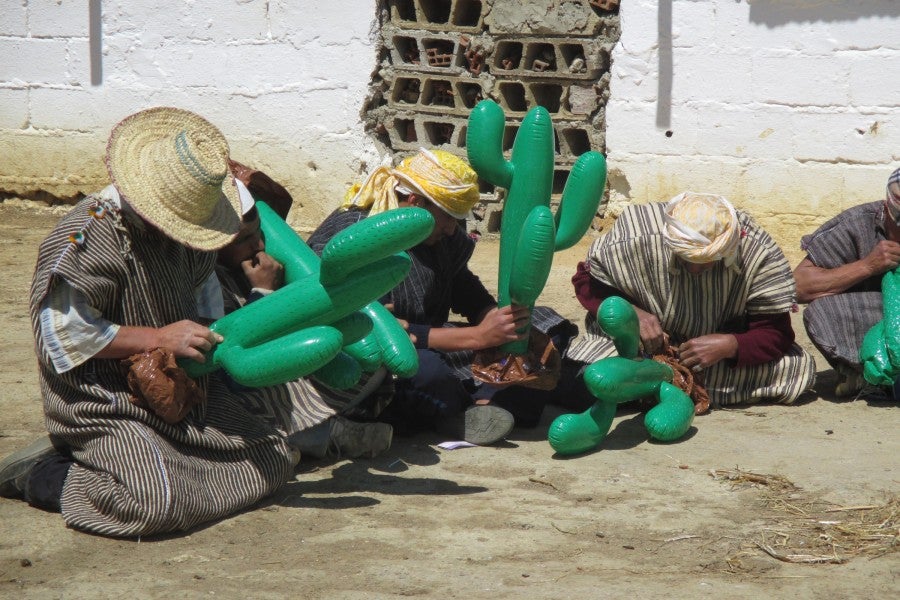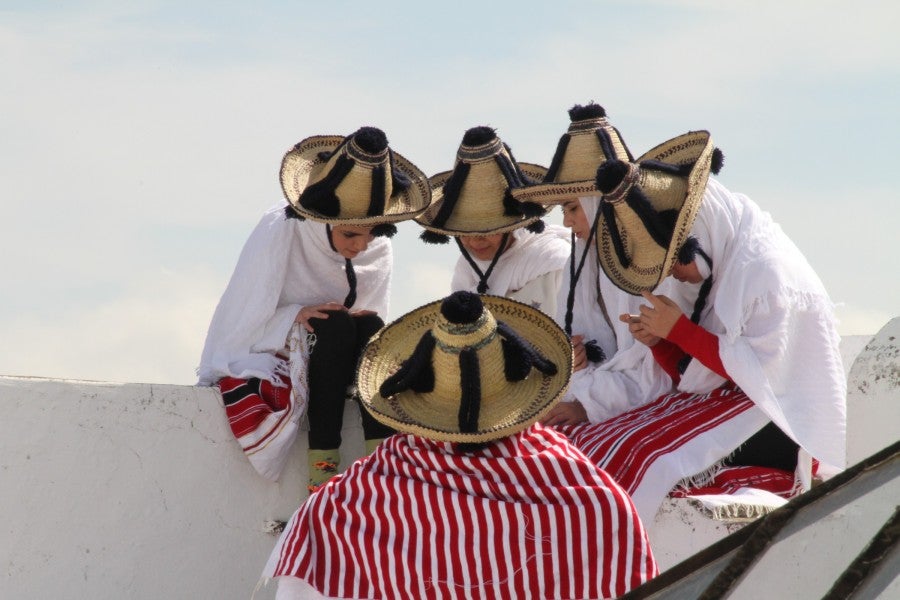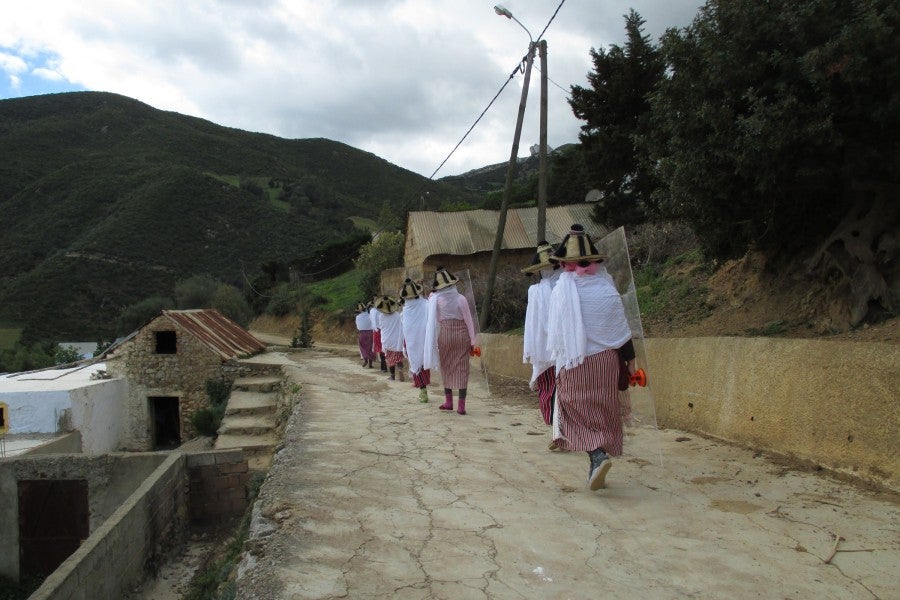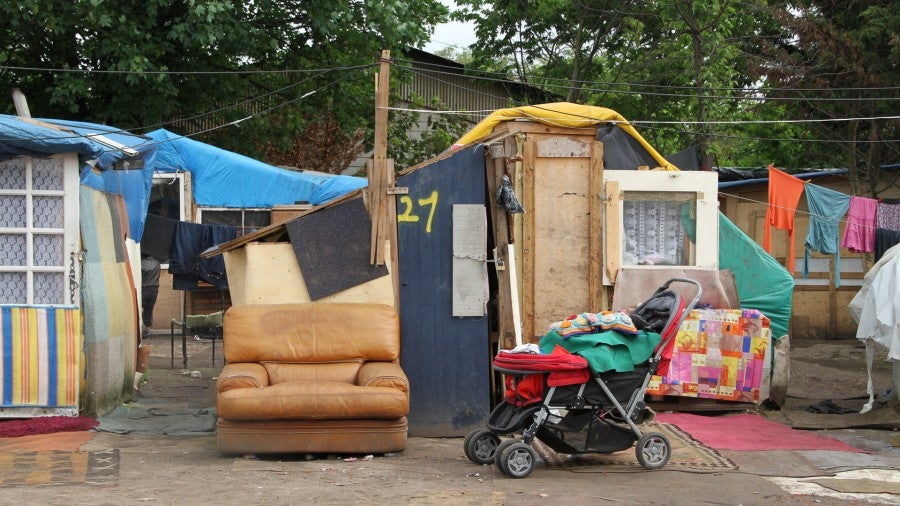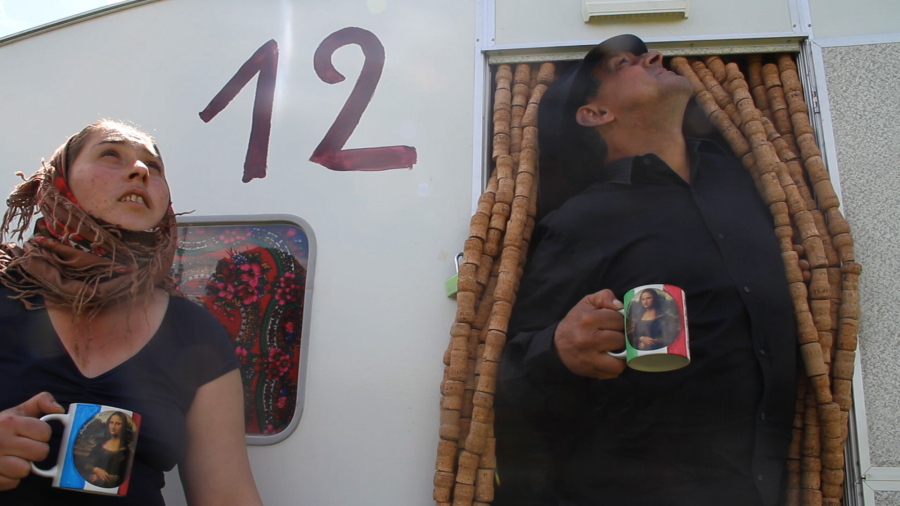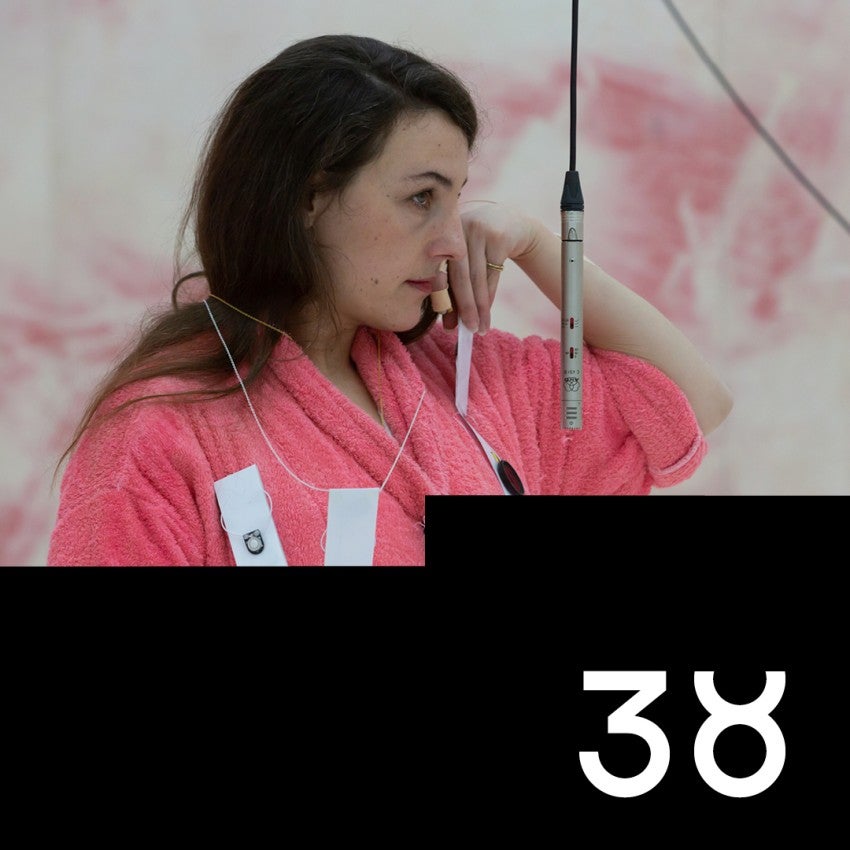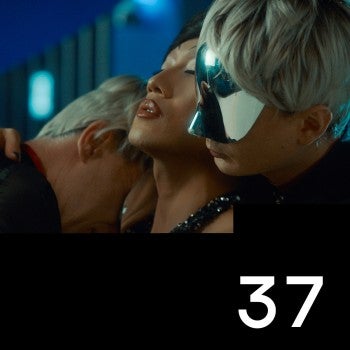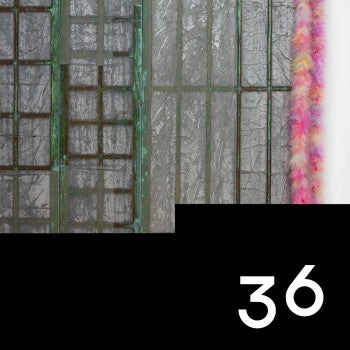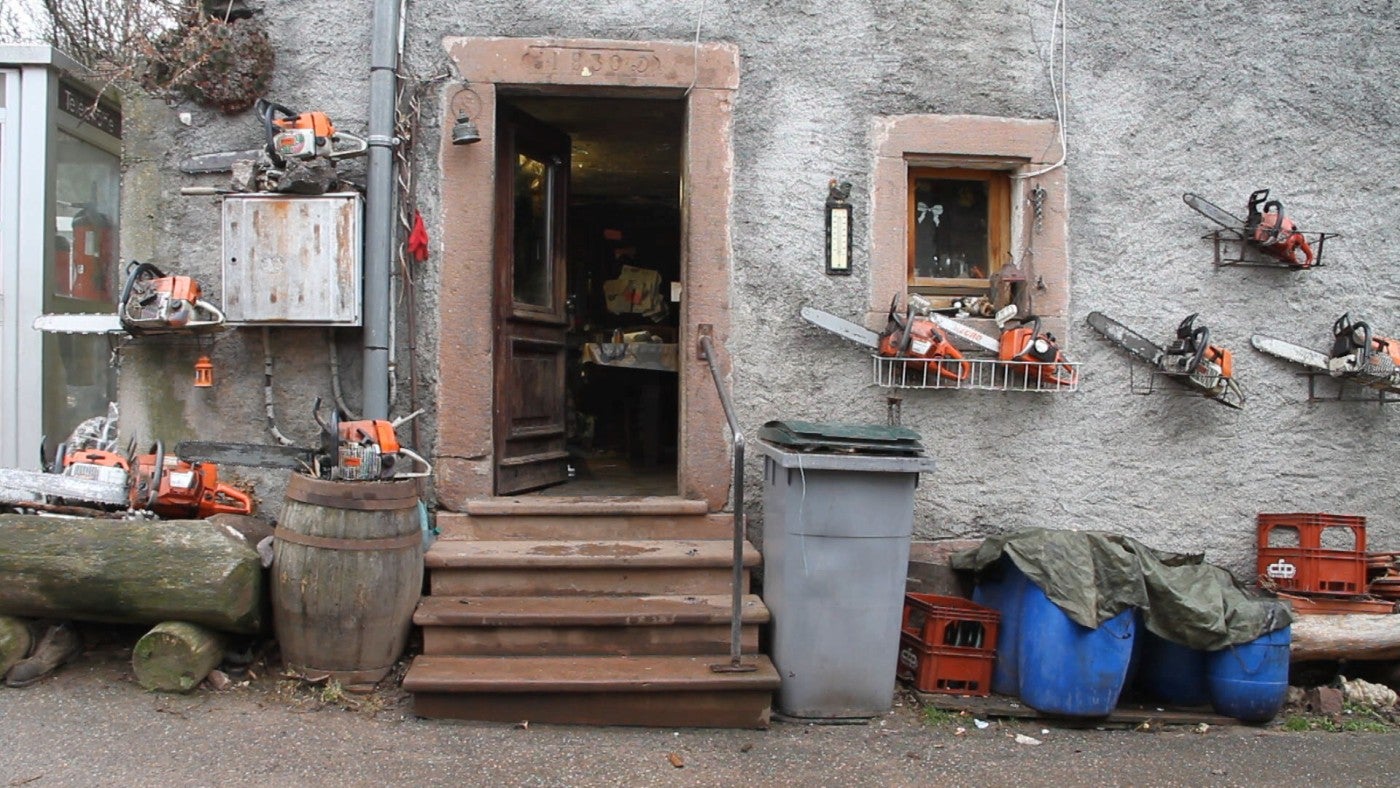
Bertille Bak, an artist living and working in Paris, has been developing for more than a decade a practice that centres on observing societies, understanding the organisation between individuals, highlighting their personal and collective histories, traditions and folklores, their hobbies and revolts. Working in collaboration with community groups, she constructs narratives between fiction and documentaries where poetry and utopias usurp the simple assessment of a situation or site.
From out of the darkness comes a cry. Then a call, which is followed, one after the other, by more calls. Apparently human, the voices join and raise into a chorus. Yelping, chanting, shouting, and yipping, the sounds appear to be coming from all sides. A din fills and defines the air, boxing it in, much like a beast trapped in the woods. The darkness clears, and the film cuts to the face of a young man. He holds one eye shut as if wincing, and then blinks repeatedly. Wearing a bright orange baseball cap, the camera holds on his close-up. Another cut, and a like man, this one in a furry hunter's cap, the kind with ear flaps, appears, and sports the same grimace. Cut again to another close-up of another similar man, however, he is older. The camera zooms out, and the three of them sit on a bench in a snow-covered field. Are they a family? Are they cold? What are they waiting for? Wearing the same, strange clothes, a kind of bearskin apron with bright orange hi-vis trim, they turn, brandish three rifles respectively, cock their barrels and aim at something out of the frame. Horns blare as the title credits flash, this is Bertille Bak's Le hameau (the hamlet), a 2014 film about a rural town of alpine hunters. At least, that's what I think I see.
As the film rolls, the audience eye more scenes from these people’s lives as if we are a fly on the wall. We are treated to a feast, some banter, and other banal—to them, but, probably not to us—scenes of their lives. For example, we watch as two men hack the hooves off a pile of severed boar limbs. Are they preparing these animal parts for a soup? Or to make some lucky charms? A few moments later, a man grabs a homemade device. It looks like some kind of clog-like shoe that you might affix over a pair of normal shoes; however, the man sets and fixes one of the cut hooves into one of the clog-like shoe's baseplate. Is this a cleat for the snow, or something else? I infer later that it is used to lay decoy animal tracks to attract, heard, or potentially confuse prey, or that's what I think it does.
...should we look to an artwork's effect on the audience to find its ethical, if not, socially expedient power?
Although Le hameau resembles a growing trend in contemporary art of the last few years toward a kind of observational, yet minimally didactic style of film-essay (of which Lydia Ourahmane and Jumana Mamma could also be included), the film is not a documentary in the traditional sense. Little context is given, nor is there much framing by way of voiceover, intertitles, interviews or any other means save a few magical realist interventions by the director—for example, a flashing sci-fi orange-line rendered over a scene in post-production, which helps me to infer that the hunter was laying some sort of false tracks with those mechanically hooved clog-like shoes.
We, the audience, are mostly left to spy their actions and come to our own conclusions about who these people are, and, for that matter, ask ourselves, why are we even watching this? For entertainment? For knowledge? Or to find some kind of bond with these individuals? Or, is it for purposes of activism, for example to advocate for isolated communities and preserve their ways of life by building ties between them and the outside world? This begets a relational question: if art can perform some form of social function, should this be measured by looking at the artwork alone, that is, within an aesthetic judgment of what is formally presented in the work itself? Or should we look to an artwork's effect on the audience to find its ethical, if not, socially expedient power? What, then, is the moral use of narrative art in general, and in the specific, what ethics are offered by artworks such as those by Bertille Bak, an artist who, as in the case of Le hameau as well as several other films that showcase not only rural life, but the lives of miners, members of the Roma community, and other persons that are traditionally on the margins of society?
In his 1996 essay, "The Artist as Ethnographer?", American art historian Hal Foster, set forth a critique of what he called the "ethnographic turn" in contemporary art. According to Foster:
Today there is a related paradigm in advanced art on the left: the artist as ethnographer. The object of contestation remains, at least in part, the bourgeois institution of autonomous art, its exclusionary definitions of art, audience, identity. But the subject of association has changed: it is now the cultural and/or ethnic other in whose name the artist often struggles. And yet, despite this shift, basic assumptions with the old productivist model persist in the new quasi-anthropological paradigm. First, there is the assumption that the site of artistic transformation is the site of political transformation, and, more, that this site is always located elsewhere, in the field of the other: in the productivist model, with the social other, the exploited proletariat; in the quasi-anthropological model, with the cultural other, the oppressed postcolonial, subaltern, or subcultural. Second, there is the assumption that this other is always outside, and, more, that this alterity is the primary point of subversion of dominant culture. Third, there is the assumption that if the invoked artist is not perceived as socially and/or culturally other, he or she has but limited access to this transformative alterity, and, more, that if he or she is perceived as other, he or she has automatic access to it. Taken together, these three assumptions lead to another point of connection with the Benjaminian account of the author as producer: the danger, for the artist as ethnographer, of "ideological patronage."1
Foster continues:
Consider this scenario, a caricature, I admit. An artist is contacted by a curator about a site-specific work. He or she is flown into town in order to engage the community targeted for collaboration by the institution. However, there is little time or money for much interaction with the community (which tends to be constructed as readymade for representation). Nevertheless, a project is designed, and an installation in the museum and/or a work in the community follows. Few of the principles of the ethnographic participant-observer are observed, let alone critiqued. And despite the best intentions of the artist, only limited engagement of the sited other is effected. Almost naturally the focus wanders from collaborative investigation to "ethnographic self-fashioning," in which the artist is not decentered so much as the other is fashioned in artistic guise.2
Central to Foster's argument is the idea that the art institution is the prime mover in this "ethnographic turn", which to use a more contemporary language, creates a form of "performativity" in which an artwork becomes an instrument by which an elite makes a claim to speak for the marginalized at best, or at worst, pretends that doing so alleviates their plight. And while Foster's criticism may still hold true for countless institutionalized artworks, Bak's work doesn't fit neatly with Foster's self-admitted "caricature".
Hailing from a community of miners herself, it should come as no surprise that Bak has produced several films with like communities; in these instances, she does not speak for these communities, she instead speaks with them. In the case of other communities not her own, Bak spends upwards of a year with each group of people she documents, unlike Foster's imaginary artist. Yet, Foster's dictum that "there is little time or money for much interaction with the community", still holds for this writer, who had no such access, as well as for almost any viewer of any film. Nor would it be correct to say that any member of a community is part-for-whole its representative. To ask a question: is it even true that extensive access to a community can ever create a position of authority?
Regardless, Foster's critique, which tellingly is posed as a rhetorical question, hides a greater concern beyond the issue of the artist as ethnographer, it is the "productivist" "assumption that the site of artistic transformation is the site of political transformation". This "assumption", as it were, holds true if one assumes "the political" as narrowly defined as a form of instrumental policy agent that creates "real change" in the world vis-a-vis measurable outcomes, be they economic, social, or otherwise. Perhaps rather than thinking that "the political" dimension of narrative art can only be proven through a causal relation—in which watching a film about x-community leads to a change, for better or for worse, in that community—let's sit instead with the idea that art develops a personal, if not inter-personal, change in the viewer. Or, said in another way, art produces a different notion of "politics" beyond the normative meaning of governance altogether.
It can be said that art helps people make sense of their own lives. Knowing what someone else has gone through can be instructive to your own lived experience, particularly, when that experience is novel. Art, to put it another way, helps people to not only know about the lives of others, but their own lives as well. Take for example, reading a work of fiction; for the sake of argument, let's consider a book I read in the early days of the COVID-19 pandemic, the Decameron.
Following an intense wave of the plague that had just swept through Florence in 1348, the Italian writer and poet Giovanni Boccaccio penned the Decameron. This collection of tales is held together by a "frame story" in which seven young women and three young men hunker down in an isolated villa to, in the modern parlance, "socially distance" themselves for two-weeks from a city wracked by pestilence. What follows is a game: excluding days set aside for chores, each person is requested to tell a story a night, so that over the course of ten days, one hundred stories will be told to pass the time. Thing is, there is a larger frame beyond this staging of social entertainments.
A pandemic was ravishing Florence, and social bonds were fading; according to Boccaccio "this scourge had implanted so great a terror in the hearts of men and women that brothers abandoned brothers, uncles their nephews, sisters their brothers... fathers and mothers refused to nurse and assist their children."3 Just as then, ours is still a time in which an invisible scourge is rendering everyone at risk. And while new medical knowledge is helping us combat the virus itself, there is still great wisdom in the old. Boccaccio himself is a survivor, and while his prescription of isolating the body still holds, his idea that being merry with the mind during a time of great misfortune is just as germane as ever. Unlike endless news reports about what the coronavirus does to the body, or what you can do to combat those threats, the greatest takeaway from the Decameron for me is that a group found solidarity in the midst of great vulnerability, and that the book instructs us how we can face our current circumstances through the means of sharing our stories with one another. These are of course fictionalizations, so can this way of learning be extended to artistic depictions of actual living persons?
While trying to grapple with the question of narrative art's social relevance beyond that of simply reporting the facts, the American philosopher and film scholar Noël Carroll wrote that:
It is one thing to be told that roadways in Mumbai are massively overcrowded, it is another thing to be given a detailed description full of illustrative incidents, emotively and perceptively portrayed. The first presents the fact: the second suggests the flavor. The first tells you that the streets are congested: the second gives a sense of what that congestion is like. The ethical critic, or at least some ethical critics, then, answer skeptics by first agreeing that the propositional knowledge available in art is often trivial or platitudinous; art is not competitive with science, philosophy, history, or even much journalism in supplying ‘knowledge that.’ But this is not the only type of knowledge there is. There is also ‘knowledge of what such and such would be like.’ . . . Moreover, this kind of knowledge is especially relevant for moral reasoning. In entertaining alternative courses of action, there is a place for the imagination.4
Let's sit with this a second. Carroll notes that narrative art is not simply a means to describe the facts of a situation, it is also a way to open up one's perception of what those conditions feel like, and moreover, it is also a way to draw an image of the context which is producing those emotions. Instead of invoking empathy, that is, the ability to project your emotions into another's others feelings, Carroll proposes that a different speculative capacity can likewise be presumed in which an "alternative course of action" can be considered.
In her Lectures on Kant's Political Philosophy, German philosopher and political scientist Hanna Arendt offers an earlier vision of this projective capability:
Critical thinking is possible only where the standpoints of all others are open to inspection. Hence, critical thinking, while still a solitary business, does not cut itself off from ‘all others.’ To be sure, it still goes on in isolation, but by the force of imagination it makes the others present and thus moves in a space that is potentially public, open to all sides; in other words, it adopts the position of Kant’s world citizen. To think with an enlarged mentality means that one trains one’s imagination to go visiting.5
Like Carroll, Arendt invokes the imagination as a means to enter another's perspective so as to try and see the world through their eyes; however, Arendt does so as a means to advance critical thinking. Her idea of projection is not to feel what "someone else feels", but to try and think what someone else thinks so as to know why they make the decisions that they do. This method doesn't intend to justify those actions, but to understand why a certain course of action was taken instead; echoing Carroll, this allows one to imagine how others act, but it also leaves open the possibility to consider how another course of action might have been taken at the same time. More than empathy alone, Arendt's "enlarged mentality" presents a form of representational thinking that draws an image, a sort of "world picture" as it were, around people's lives so that someone else can try to imagine their world-view.
[Bak] opens a window onto their lives, which in turn, allows me to figuratively enter their world; it is a way to "connect, the unconnected" by proxy.
The "play is the thing", however, more than simply catching the audience's conscience, the theatricality of narrative art presents a stage for the audience in which to not only understand a state of affairs, but to consider how to act within it, if not to change it. According to French philosopher Jacques Rancière:
Politics consists in playing or acting out this relationship, which means first setting it up as a theatre, inventing the argument, in the double logical and dramatic sense of the term, connecting the unconnected.6
Let's now return to our hunters in Alsace. It's true, before watching the film, I didn't know of the hunters' existence; however, learning that they do exist provides little more than a statement of fact. Eschewing talking heads or an omniscient narrator, I also cannot tell if there is really anything special about their situation, other than the fact that it's different from my own. What Bak does opens a window onto their lives, which in turn, allows me to figuratively enter their world; it is a way to "connect, the unconnected" by proxy. . . but to what end?
As implied above, Bak's work can easily be considered as a form of ethnography, wherein the artist embeds herself with a given community, watches them, participates in their activities, and then films and edits those activities for others to see in museums, galleries, and other institutions of the artworld. But only so much can be understood by looking alone, and as such, there is more than one form of ethnographic methodology.
In addition to sight, people perceive the world though non-visual means, for example, knowing how the weight of a bearskin apron makes you feel, or for that matter, how the use of various tools, such a hoofed clog shoe, establishes an embodied understanding of the landscape. In Le hameau, we watch as a young man runs around on all fours pretending to be some kind of dog. In turn, he addresses a group of hunters as a dog would, however, those hunters tell him he's not quite getting it right, "you need to be more proud [sic]", says one hunter.
In another film, Transports à dos d’hommes (Borne on Men’s Backs) (2012), we watch as two men, members of the Roma community, practice playing the accordion in the trailer of an encampment outside of Paris. Yet, instead using a metronome to keep the beat, their colleague runs a repurposed map, replete with flashing lights, of the Paris metro to measure the amount of time each player has between train stops. In addition, the rehearsal is framed by an audio speaker that plays back a recording of the sound of the Metro in motion to complete a sort of train-simulator in order for the players to hone their work as train buskers. And while I can infer all this from what Bak's camera shows me, her lack of voice-over presents a kind of embodied understanding of the musicians' craft, its rigor, and its pressures.
While writing about Leviathan, a 2012 American documentary-as-a-ride-along on a fishing trawler directed by Lucien Castaing-Taylor and Véréna Paravel of Harvard University's Sensory Ethnography Lab, French film critic Cyril Neyrat notes how the history of cinema is "the conquest of the perceptible tied to an adventure in visibility."7 Said in another way, film, although immersive, is limited to only audio and visual means, and thus is locked in an ongoing struggle to over-compensate for its inability to give the viewer a fully embedded sensory experience by amplifying it's two available media. While Taylor and Paravel, like many contemporary nature documentarians, peruse greater and greater technological means, such as attaching miniature cameras onto drones in the sea to give hyper-realistic "fish-eye" visions of what was hitherto fore invisible to people in everyday life, Bak turns to lo-fi post-production special effects, such as the flashing orange-line in Le hameau, or the use of ray gun-like buzzes to augment the musicians' DIY simulator in Transports à dos d’hommes, to make obvious her role as a director, and to remind the audience that everything they are watching is a construction. This overt distancing tacks a radically different course than the trend in contemporary sensory-heavy documentary, which hides the fact that the heightened awareness produced by new technology is itself artifice. In so doing, Bak's films teasingly turn away from making any demonstrative truth claims about her subjects, which, I believe is why she generally avoids other framing devices typically used in documentaries such as the use of a narrator. Whether or not this provides enough "critical distance", remains to be seen, however, it does call to attention that while Bak's films document communities, they are, and will always be, just one of many representations.
Ethnography is a field fraught with concerns of malpractice, and the closeness of Bak's (along with other filmmakers') work to this discipline elicits the question: is the work ethical? I can't answer this question; however, I fear such a dilemma stems not from an engagement with artworks themselves, but from a greater movement in art discourse running in parallel to Foster's thorough critique of the productivist artist as ethnographer, that "good" political art should somehow provide quantifiable "deliverables". But perhaps, this is asking the wrong question? Art, if it can be said, "builds worlds" as a way to review our own; it's your job, not the artist's, if you so desire, to make those other worlds your reality, either personally or interpersonally. As such, why not learn from a film, or any another other artwork what you can, instead of approaching it as a problem? And if this new knowledge inspires you to see more, learn more, or even do more, please do so. . . I'll be right by your side.
see: https://monoskop.org/images/8/87/Foster_Hal_1995_The_Artist_as_Ethnographer.pdf
Ibid.
Boccaccio, Giovanni. The Decameron. Translated by G. H. McWilliam. 2nd ed. London: Penguin Books, 1995, 8–9. Annotated by Shona Kelly Wray.
Carroll, N., “Art and Ethical Criticism: An Overview of Recent Directions of Research,” Ethics, (Vol. 110, 2000)
see: https://hac.bard.edu/amor-mundi/critical-thinking-judgment-and-empathy-2015-04-20
Rancière quoted in Hallward, ‘Staging Equality’, p. 111.
See: http://cinemaguild.com/homevideo/ess_leviathan.htm
